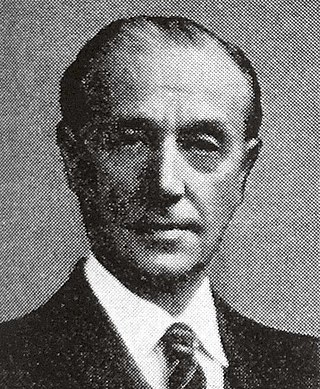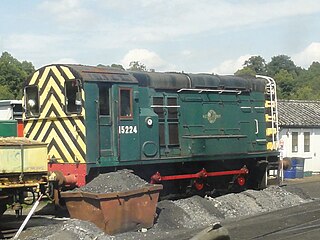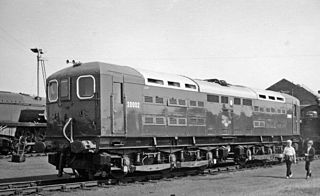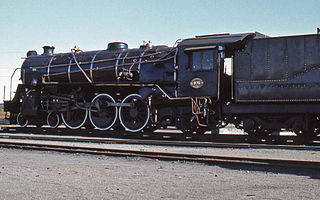
Oliver Vaughan Snell Bulleid CBE was a British railway and mechanical engineer best known as the Chief Mechanical Engineer (CME) of the Southern Railway between 1937 and the 1948 nationalisation, developing many well-known locomotives.

The Southern Railway (SR), sometimes shortened to 'Southern', was a British railway company established in the 1923 Grouping. It linked London with the Channel ports, South West England, South coast resorts and Kent. The railway was formed by the amalgamation of several smaller railway companies, the largest of which were the London and South Western Railway (LSWR), the London, Brighton and South Coast Railway (LB&SCR) and the South Eastern and Chatham Railway (SE&CR). The construction of what was to become the Southern Railway began in 1838 with the opening of the London and Southampton Railway, which was renamed the London & South Western Railway.

The British Rail Class 12 is a diesel locomotive built primarily for shunting duties around London.

The LSWR N15 class was a British 2–cylinder 4-6-0 express passenger steam locomotive designed by Robert Urie. The class has a complex build history spanning three sub-classes and eight years of construction from 1918 to 1927. The first batch of the class was constructed for the London and South Western Railway (LSWR), where they hauled heavy express passenger trains to the south coast ports and further west to Exeter. After the Lord Nelsons, they were the second biggest 4-6-0 passenger locomotives on the Southern Railway. They could reach speeds of up to 90 mph (145 km/h).

The SR Q1 class is a type of austerity steam locomotive constructed during the Second World War. The class was designed by Oliver Bulleid for use on the intensive freight turns experienced during wartime on the Southern Railway network. A total of 40 locomotives were built. Bulleid incorporated many innovations and weight-saving concepts to produce a highly functional design. The class lasted in service until July 1966, and the first member of the class, number C1, has been preserved by the National Railway Museum.

The SR West Country and Battle of Britain classes, collectively known as Light Pacifics or informally as Spam Cans, are air-smoothed 4-6-2 Pacific steam locomotives designed for the Southern Railway by its Chief Mechanical Engineer Oliver Bulleid. Incorporating a number of new developments in British steam locomotive technology, they were amongst the first British designs to use welding in the construction process, and to use steel fireboxes, which meant that components could be more easily constructed under wartime austerity and post-war economy.

The British Rail Class 70 was a class of three third rail Co-Co electric locomotives. The initial two were built by the Southern Railway (SR) at Ashford Works in 1940–41 and 1945 and were numbered CC1 and CC2 - the Southern Railway latterly preferring French practice for locomotive numbers which also gave an indication of the wheel arrangement. Electrical equipment was designed by Alfred Raworth and the body and bogies by Oliver Bulleid. CC2 was modified slightly from the original design by C. M. Cock who had succeeded Raworth as Electrical Engineer. The third was built by British Railways in 1948 and numbered 20003.

The Leader was a class of experimental 0-6-0+0-6-0T steam locomotive]], produced in the United Kingdom to the design of the innovative engineer Oliver Bulleid. The Leader was an attempt to extend the life of steam traction by eliminating many of the operational drawbacks associated with existing steam locomotives. It was intended as a replacement for the ageing fleet of M7 class tank engines still in operation on the Southern Railway (SR). Design work began in 1946 and development continued after the nationalisation of the railways in 1948, under the auspices of British Railways (BR).

11001 was one of the first British Railways diesel locomotives, built in 1949 at British Railways' Ashford railway works. It was designed by O. V. S. Bulleid when he was Chief Mechanical Engineer of the Southern Railway. It was powered by a Paxman RPH Series 1 engine, capable of delivering 500 brake horsepower (370 kW) at 1,250 rpm. It was driven via a Vulcan-Sinclair fluid coupling to an SSS (synchro-self-shifting) Powerflow gearbox. The gearbox provided three forward and reverse gears in either high or low range, with top speed ranging from 5 mph (8 km/h) in 1st gear, low range up to 36 mph (58 km/h). It had a 0-6-0 wheel formation, driven by rods from a rear jackshaft on the final drive, and with Bulleid's favoured BFB wheels.

A Boxpok is a steam locomotive wheel that gains its strength through being made of a number of box sections rather than having traditional solid spokes. Being hollow, they allow better counterbalancing and stability than conventional drivers, which is important for fast locomotives. The Boxpok wheel was patented by General Steel Castings Corporation of Granite City, Illinois.

The SECR N class was a type of 2-6-0 ("mogul") steam locomotive designed in 1914 by Richard Maunsell for mixed-traffic duties on the South Eastern and Chatham Railway (SECR). Built between 1917 and 1934, it was the first non-Great Western Railway (GWR) type to use and improve upon the basic design principles established by GWR Chief Mechanical Engineer (CME) George Jackson Churchward. The N class was based on the GWR 4300 Class design, improved with Midland Railway concepts.

SCOA-P pattern wheels are a type of steam locomotive wheel. Rather than having traditional solid spokes, the SCOA-P spoke is hollow, with a 'U' shaped cross section. They are considerably lighter than a conventional spoked wheel or Boxpok wheel of the same size and strength.

The LSWR Class S11 was a class of 10 4-4-0 steam locomotives designed for express passenger work by Dugald Drummond. They were introduced to services on the London and South Western Railway in 1903. None of the class survived into preservation after their brief career in British Railways ownership.
Firth Brown Steels was initially formed in 1902, when Sheffield steelmakers John Brown & Company exchanged shares and came to a working agreement with neighbouring company Thomas Firth & Sons. In 1908 the two companies came together and established the Brown Firth Research Laboratories and it was here, in 1912, under the leadership of Harry Brearley they developed high chrome stainless steel. The companies continued under their own management until they formally merged in 1930 becoming Firth Brown Steels. The company is now part of Sheffield Forgemasters.

Under the Whyte notation for the classification of steam locomotives, 0-6-0+0-6-0 represents the wheel arrangement of an articulated locomotive with two separate swivelling engine units, each unit with no leading wheels, six powered and coupled driving wheels on three axles and no trailing wheels. The arrangement is effectively two 0-6-0 locomotives operating back-to-back and was used on Garratt, Double Fairlie, Meyer and Kitson-Meyer articulated locomotives. A similar arrangement exists for Mallet steam locomotives on which only the front engine unit swivels, but these are referred to as 0-6-6-0.

The SR Merchant Navy class is a class of air-smoothed 4-6-2 (Pacific) steam locomotives designed for the Southern Railway by Oliver Bulleid. The Pacific design was chosen in preference to several others proposed by Bulleid. The first members of the class were constructed during the Second World War, and the last of the 30 locomotives in 1949.

The wobbly-web wheel is a form of metal disc wheel where the disc is 'wobbled' into spokes. This provides a stiffer, lightweight wheel.

The South African Railways Class 16DA 4-6-2 of 1928 was a steam locomotive.

The South African Railways Class 16DA 4-6-2 of 1930 is a class of steam locomotives.



















